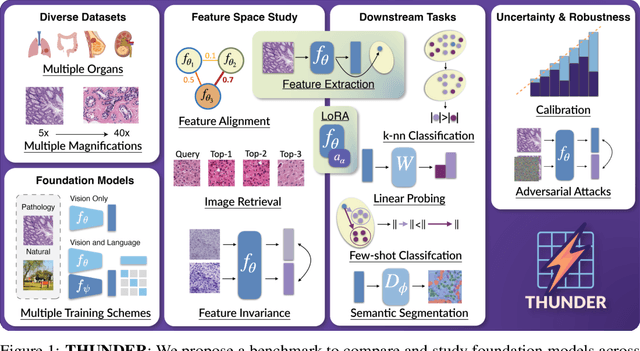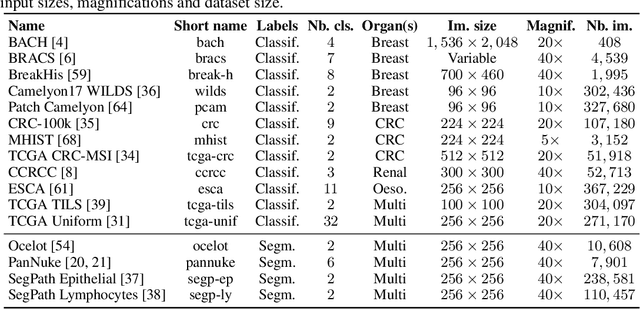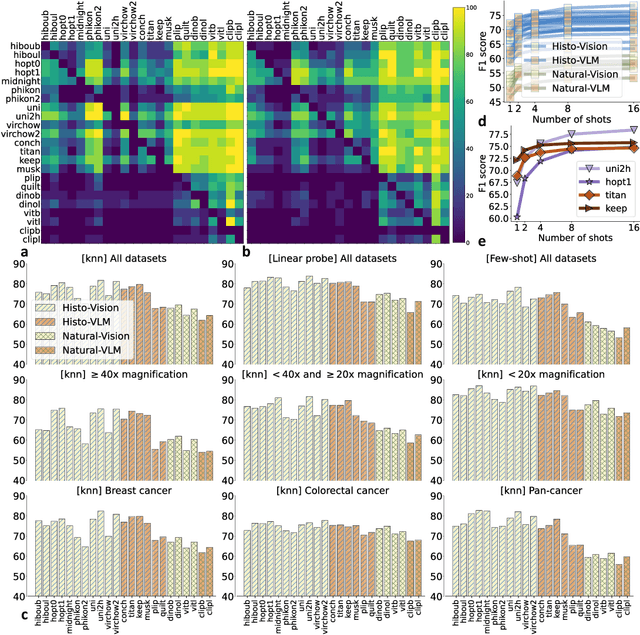Christian Desrosiers
Revisiting the Learning Objectives of Vision-Language Reward Models
Dec 20, 2025Abstract:Learning generalizable reward functions is a core challenge in embodied intelligence. Recent work leverages contrastive vision language models (VLMs) to obtain dense, domain-agnostic rewards without human supervision. These methods adapt VLMs into reward models through increasingly complex learning objectives, yet meaningful comparison remains difficult due to differences in training data, architectures, and evaluation settings. In this work, we isolate the impact of the learning objective by evaluating recent VLM-based reward models under a unified framework with identical backbones, finetuning data, and evaluation environments. Using Meta-World tasks, we assess modeling accuracy by measuring consistency with ground truth reward and correlation with expert progress. Remarkably, we show that a simple triplet loss outperforms state-of-the-art methods, suggesting that much of the improvements in recent approaches could be attributed to differences in data and architectures.
NERVE: Neighbourhood & Entropy-guided Random-walk for training free open-Vocabulary sEgmentation
Nov 11, 2025Abstract:Despite recent advances in Open-Vocabulary Semantic Segmentation (OVSS), existing training-free methods face several limitations: use of computationally expensive affinity refinement strategies, ineffective fusion of transformer attention maps due to equal weighting or reliance on fixed-size Gaussian kernels to reinforce local spatial smoothness, enforcing isotropic neighborhoods. We propose a strong baseline for training-free OVSS termed as NERVE (Neighbourhood \& Entropy-guided Random-walk for open-Vocabulary sEgmentation), which uniquely integrates global and fine-grained local information, exploiting the neighbourhood structure from the self-attention layer of a stable diffusion model. We also introduce a stochastic random walk for refining the affinity rather than relying on fixed-size Gaussian kernels for local context. This spatial diffusion process encourages propagation across connected and semantically related areas, enabling it to effectively delineate objects with arbitrary shapes. Whereas most existing approaches treat self-attention maps from different transformer heads or layers equally, our method uses entropy-based uncertainty to select the most relevant maps. Notably, our method does not require any conventional post-processing techniques like Conditional Random Fields (CRF) or Pixel-Adaptive Mask Refinement (PAMR). Experiments are performed on 7 popular semantic segmentation benchmarks, yielding an overall state-of-the-art zero-shot segmentation performance, providing an effective approach to open-vocabulary semantic segmentation.
Reinforcement Learning for Unsupervised Domain Adaptation in Spatio-Temporal Echocardiography Segmentation
Oct 16, 2025Abstract:Domain adaptation methods aim to bridge the gap between datasets by enabling knowledge transfer across domains, reducing the need for additional expert annotations. However, many approaches struggle with reliability in the target domain, an issue particularly critical in medical image segmentation, where accuracy and anatomical validity are essential. This challenge is further exacerbated in spatio-temporal data, where the lack of temporal consistency can significantly degrade segmentation quality, and particularly in echocardiography, where the presence of artifacts and noise can further hinder segmentation performance. To address these issues, we present RL4Seg3D, an unsupervised domain adaptation framework for 2D + time echocardiography segmentation. RL4Seg3D integrates novel reward functions and a fusion scheme to enhance key landmark precision in its segmentations while processing full-sized input videos. By leveraging reinforcement learning for image segmentation, our approach improves accuracy, anatomical validity, and temporal consistency while also providing, as a beneficial side effect, a robust uncertainty estimator, which can be used at test time to further enhance segmentation performance. We demonstrate the effectiveness of our framework on over 30,000 echocardiographic videos, showing that it outperforms standard domain adaptation techniques without the need for any labels on the target domain. Code is available at https://github.com/arnaudjudge/RL4Seg3D.
THUNDER: Tile-level Histopathology image UNDERstanding benchmark
Jul 10, 2025



Abstract:Progress in a research field can be hard to assess, in particular when many concurrent methods are proposed in a short period of time. This is the case in digital pathology, where many foundation models have been released recently to serve as feature extractors for tile-level images, being used in a variety of downstream tasks, both for tile- and slide-level problems. Benchmarking available methods then becomes paramount to get a clearer view of the research landscape. In particular, in critical domains such as healthcare, a benchmark should not only focus on evaluating downstream performance, but also provide insights about the main differences between methods, and importantly, further consider uncertainty and robustness to ensure a reliable usage of proposed models. For these reasons, we introduce THUNDER, a tile-level benchmark for digital pathology foundation models, allowing for efficient comparison of many models on diverse datasets with a series of downstream tasks, studying their feature spaces and assessing the robustness and uncertainty of predictions informed by their embeddings. THUNDER is a fast, easy-to-use, dynamic benchmark that can already support a large variety of state-of-the-art foundation, as well as local user-defined models for direct tile-based comparison. In this paper, we provide a comprehensive comparison of 23 foundation models on 16 different datasets covering diverse tasks, feature analysis, and robustness. The code for THUNDER is publicly available at https://github.com/MICS-Lab/thunder.
Prompt learning with bounding box constraints for medical image segmentation
Jul 03, 2025Abstract:Pixel-wise annotations are notoriously labourious and costly to obtain in the medical domain. To mitigate this burden, weakly supervised approaches based on bounding box annotations-much easier to acquire-offer a practical alternative. Vision foundation models have recently shown noteworthy segmentation performance when provided with prompts such as points or bounding boxes. Prompt learning exploits these models by adapting them to downstream tasks and automating segmentation, thereby reducing user intervention. However, existing prompt learning approaches depend on fully annotated segmentation masks. This paper proposes a novel framework that combines the representational power of foundation models with the annotation efficiency of weakly supervised segmentation. More specifically, our approach automates prompt generation for foundation models using only bounding box annotations. Our proposed optimization scheme integrates multiple constraints derived from box annotations with pseudo-labels generated by the prompted foundation model. Extensive experiments across multimodal datasets reveal that our weakly supervised method achieves an average Dice score of 84.90% in a limited data setting, outperforming existing fully-supervised and weakly-supervised approaches. The code is available at https://github.com/Minimel/box-prompt-learning-VFM.git
Test-Time Adaptation of Vision-Language Models for Open-Vocabulary Semantic Segmentation
May 28, 2025Abstract:Recently, test-time adaptation has attracted wide interest in the context of vision-language models for image classification. However, to the best of our knowledge, the problem is completely overlooked in dense prediction tasks such as Open-Vocabulary Semantic Segmentation (OVSS). In response, we propose a novel TTA method tailored to adapting VLMs for segmentation during test time. Unlike TTA methods for image classification, our Multi-Level and Multi-Prompt (MLMP) entropy minimization integrates features from intermediate vision-encoder layers and is performed with different text-prompt templates at both the global CLS token and local pixel-wise levels. Our approach could be used as plug-and-play for any segmentation network, does not require additional training data or labels, and remains effective even with a single test sample. Furthermore, we introduce a comprehensive OVSS TTA benchmark suite, which integrates a rigorous evaluation protocol, seven segmentation datasets, and 15 common corruptions, with a total of 82 distinct test scenarios, establishing a standardized and comprehensive testbed for future TTA research in open-vocabulary segmentation. Our experiments on this suite demonstrate that our segmentation-tailored method consistently delivers significant gains over direct adoption of TTA classification baselines.
SMART-PC: Skeletal Model Adaptation for Robust Test-Time Training in Point Clouds
May 26, 2025Abstract:Test-Time Training (TTT) has emerged as a promising solution to address distribution shifts in 3D point cloud classification. However, existing methods often rely on computationally expensive backpropagation during adaptation, limiting their applicability in real-world, time-sensitive scenarios. In this paper, we introduce SMART-PC, a skeleton-based framework that enhances resilience to corruptions by leveraging the geometric structure of 3D point clouds. During pre-training, our method predicts skeletal representations, enabling the model to extract robust and meaningful geometric features that are less sensitive to corruptions, thereby improving adaptability to test-time distribution shifts. Unlike prior approaches, SMART-PC achieves real-time adaptation by eliminating backpropagation and updating only BatchNorm statistics, resulting in a lightweight and efficient framework capable of achieving high frame-per-second rates while maintaining superior classification performance. Extensive experiments on benchmark datasets, including ModelNet40-C, ShapeNet-C, and ScanObjectNN-C, demonstrate that SMART-PC achieves state-of-the-art results, outperforming existing methods such as MATE in terms of both accuracy and computational efficiency. The implementation is available at: https://github.com/AliBahri94/SMART-PC.
DART$^3$: Leveraging Distance for Test Time Adaptation in Person Re-Identification
May 23, 2025Abstract:Person re-identification (ReID) models are known to suffer from camera bias, where learned representations cluster according to camera viewpoints rather than identity, leading to significant performance degradation under (inter-camera) domain shifts in real-world surveillance systems when new cameras are added to camera networks. State-of-the-art test-time adaptation (TTA) methods, largely designed for classification tasks, rely on classification entropy-based objectives that fail to generalize well to ReID, thus making them unsuitable for tackling camera bias. In this paper, we introduce DART$^3$, a TTA framework specifically designed to mitigate camera-induced domain shifts in person ReID. DART$^3$ (Distance-Aware Retrieval Tuning at Test Time) leverages a distance-based objective that aligns better with image retrieval tasks like ReID by exploiting the correlation between nearest-neighbor distance and prediction error. Unlike prior ReID-specific domain adaptation methods, DART$^3$ requires no source data, architectural modifications, or retraining, and can be deployed in both fully black-box and hybrid settings. Empirical evaluations on multiple ReID benchmarks indicate that DART$^3$ and DART$^3$ LITE, a lightweight alternative to the approach, consistently outperforms state-of-the-art TTA baselines, making for a viable option to online learning to mitigate the adverse effects of camera bias.
Correcting Deviations from Normality: A Reformulated Diffusion Model for Multi-Class Unsupervised Anomaly Detection
Mar 25, 2025Abstract:Recent advances in diffusion models have spurred research into their application for Reconstruction-based unsupervised anomaly detection. However, these methods may struggle with maintaining structural integrity and recovering the anomaly-free content of abnormal regions, especially in multi-class scenarios. Furthermore, diffusion models are inherently designed to generate images from pure noise and struggle to selectively alter anomalous regions of an image while preserving normal ones. This leads to potential degradation of normal regions during reconstruction, hampering the effectiveness of anomaly detection. This paper introduces a reformulation of the standard diffusion model geared toward selective region alteration, allowing the accurate identification of anomalies. By modeling anomalies as noise in the latent space, our proposed Deviation correction diffusion (DeCo-Diff) model preserves the normal regions and encourages transformations exclusively on anomalous areas. This selective approach enhances the reconstruction quality, facilitating effective unsupervised detection and localization of anomaly regions. Comprehensive evaluations demonstrate the superiority of our method in accurately identifying and localizing anomalies in complex images, with pixel-level AUPRC improvements of 11-14% over state-of-the-art models on well known anomaly detection datasets. The code is available at https://github.com/farzad-bz/DeCo-Diff
Spectral State Space Model for Rotation-Invariant~Visual~Representation~Learning
Mar 09, 2025Abstract:State Space Models (SSMs) have recently emerged as an alternative to Vision Transformers (ViTs) due to their unique ability of modeling global relationships with linear complexity. SSMs are specifically designed to capture spatially proximate relationships of image patches. However, they fail to identify relationships between conceptually related yet not adjacent patches. This limitation arises from the non-causal nature of image data, which lacks inherent directional relationships. Additionally, current vision-based SSMs are highly sensitive to transformations such as rotation. Their predefined scanning directions depend on the original image orientation, which can cause the model to produce inconsistent patch-processing sequences after rotation. To address these limitations, we introduce Spectral VMamba, a novel approach that effectively captures the global structure within an image by leveraging spectral information derived from the graph Laplacian of image patches. Through spectral decomposition, our approach encodes patch relationships independently of image orientation, achieving rotation invariance with the aid of our Rotational Feature Normalizer (RFN) module. Our experiments on classification tasks show that Spectral VMamba outperforms the leading SSM models in vision, such as VMamba, while maintaining invariance to rotations and a providing a similar runtime efficiency.
 Add to Chrome
Add to Chrome Add to Firefox
Add to Firefox Add to Edge
Add to Edge